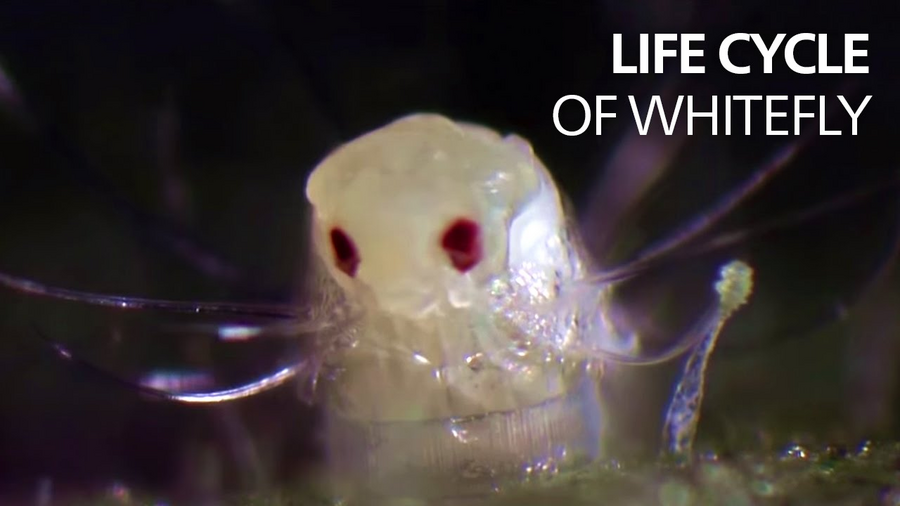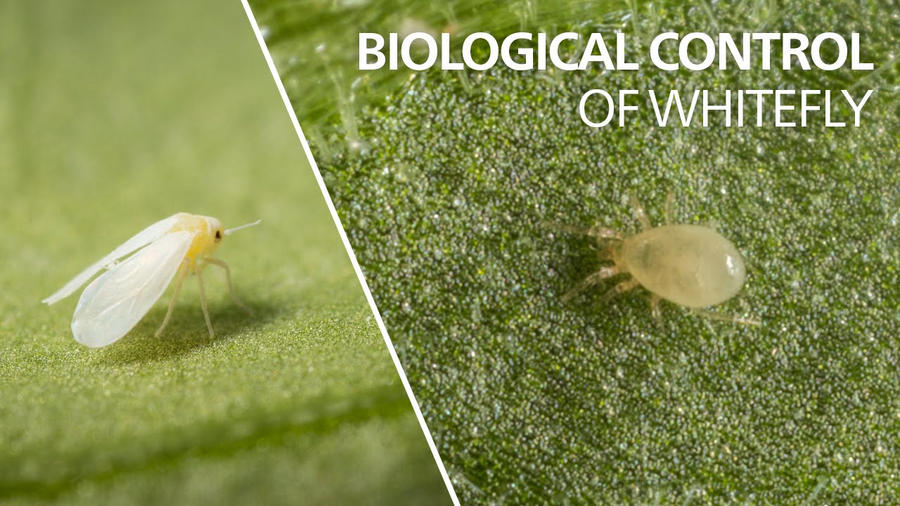What are whiteflies?
Whiteflies are a group of small, winged insects that belong to the family Aleyrodidae. They are called "whiteflies" because they are typically white or yellowish in color, and they are often found on the undersides of leaves.
Whiteflies are not true flies but belong to the order Hemiptera (true bugs). Together with aphids and scale insects, they belong to the division Sternorrhyncha. The most common species are the greenhouse whitefly, Trialeurodes vaporariorum, and the tobacco whitefly, Bemisia tabaci. Both are widespread, polyphagous and are broadly comparable in outline.
Whitefly can be found in many different environments, but they are particularly common in greenhouse settings and in agricultural fields. They feed on the sap of plants, which can cause damage to the leaves and stunting of growth. They can also transmit plant viruses from one plant to another.
Life cycle of whitefly
Whiteflies have six distinct developmental stages: the egg, first, second, third and fourth larval instars, and an adult insect.
The eggs are elliptical and often deposited in circles. The young larvae, which on hatching already have well-developed legs and antennae, are known as, ‘crawlers’. After hatching they are actively engaged for several hours in seeking a suitable place on the leaf where they can feed. Once they have found such a spot, they remain there throughout the period of larval development. In the second and third larval stages, both the legs and the antennae are reduced to one or two segments and are no longer visible. In the fourth larval stage, the insect finally becomes flatter, then subsequently fatter, and the cuticle hardens.
The growth of hairs on the insect depends on the leaf: the longer the hairs on the leaf, the longer the hairs on the insect. In other words, the larva adapts itself to the structure of the leaf on which it lives. On very hairy leaves, the larva can sometimes become deformed if the growth is obstructed by the stiff hairs. As soon as the red eyes of the adult whitefly are visible in the fourth larval instar, the stage is referred to as a ‘pupa’. The different species of whitefly can be most easily distinguished from each other at the pupal stage.
The adult emerges from the hardened cuticle of the pupa through a characteristically shaped opening; the pupa splits on the upper surface along pre-existing seams, to create a T-shaped opening. Newly emerged whiteflies have two pairs of transparent wings; later these two pairs of wings and the body are covered with a white, waxy powder that gives the insect its characteristic appearance. Adult whiteflies are mostly found on the underside of young leaves where they lay their eggs. If the plant is shaken, the adults fly up, and then return to the undersides of leaves.
Recognize whitefly
Whiteflies can be identified by the following characteristics:
- Size and shape: Whiteflies are small, winged insects that are typically about 1-2 mm in length. They have a distinctive, triangular shape and hold their wings in a vertical position over their body when at rest.
- Color: As their name suggests, whiteflies are usually white or pale yellow in color. This is due to the wax produced by the adults, which is covering their body and wings. Some species have dark markings on their wings or bodies.
- Movement: Whiteflies are weak fliers and tend to flutter around plants rather than fly in a straight line. They are often found on the undersides of leaves, where they feed on plant sap.
- Damage: Whiteflies can cause damage to leaves by feeding on plant sap. This can result in yellowing, wilting, or premature leaf drop.
If you suspect that you have a whitefly infestation, it's important to confirm their presence and take appropriate measures to control their population.
Whitefly damage
The damage caused by whiteflies can be recognized by several visible signs. Here are some of the common signs of whitefly damage:
- Yellowing of leaves: Whiteflies feed on plant sap, which can cause the leaves of infested plants to turn yellow and eventually drop off. This yellowing is often more pronounced on the lower leaves of the plant.
- Stunted growth: Whitefly infestations can also cause plants to grow more slowly or become stunted. This is because the insects are drawing nutrients away from the plant as they feed on its sap.
- Sticky residue: Whiteflies excrete a sugary substance called honeydew, which can coat the leaves and stems of infested plants.
- Sooty mold: Honeydew can also promote the growth of a black, sooty mold that can cover the leaves and stems of infested plants. This mold can further reduce the plant's ability to photosynthesize and grow.
- Wilting or death of plant: In severe cases, whitefly infestations can cause plants to wilt and die. This can occur when the insects are present in very large numbers and are feeding heavily on the plant.
Whitefly damage
How to prevent whitefly
To prevent whitefly infestations in crops, there are several measures you can take:
Implement good crop management practices
Maintain plant health by providing proper irrigation, nutrition, and adequate spacing between plants. Healthy plants are less susceptible to whitefly infestations.
Practice strict hygiene
Keep the growing area clean and free from debris, weeds, and plant residues that can serve as reservoirs for whiteflies. Regularly remove and dispose of any infested plant material.
Monitor regularly
Regularly inspect your crops for signs of whiteflies, including adult insects, nymphs, or their characteristic sticky honeydew. To aid in monitoring, strategically position sticky traps throughout the crop to capture adult whiteflies and provide insight into population levels. Early detection allows for prompt action and prevents the infestation from spreading.
Use physical barriers in greenhouses
Install insect-proof screens on openings such as vents and doors to prevent whiteflies from entering the crop area. This helps create a physical barrier and reduces the chances of infestation.
Introduce biological control agents
Utilize natural enemies of whiteflies such as parasitic wasps, predatory mites, predatory bugs, or entomopathogenic fungi. These beneficial organisms can help control whitefly populations by feeding on them or their eggs.
Rotate crops and plant diversity – outdoor crops
Avoid continuous cropping of susceptible plant species. Rotate crops to disrupt whitefly life cycles and reduce the buildup of infestations. Additionally, planting a diverse range of crops can create an environment less favorable for whiteflies.
Whitefly control videos
Take a look at the video or go to our Youtube channel to see our whitefly control products in action.

